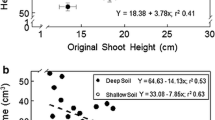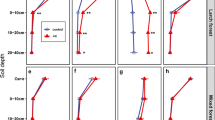Abstract
The relative influence of seed and microsite availability in the seedling emergence and recruitment of Liaodong oak (Quercus wutaishanica), which dominates the native hardwood forest in Loess Plateau, was examined by seed sowing experiments. Experiments were performed in 216 plots (30 × 30 cm), located in three typical stands (Pinus tabulaeformis plantation, Liaodong oak forest and grassland, 72 plots per stand). A seed augmentation experiment was performed in an oak forest and a conifer plantation, and a seed introduction experiment was carried out in a grassland. Three main factors were considered: seed addition, disturbance and shrub cover. The seedling number and growth in every plot were recorded continuously over 3 years. GLM multivariate was used to analyze the relationships between seedling emergence/recruitment and the explanatory variables in every stand. The results showed that seed addition in undisturbed or disturbed plots always caused significantly increased seedling emergence and recruitment in oak and conifer forests. It demonstrated that the recruitment of Liaodong oak was limited by seed and microsite availability under closed forest, and litter is one of the factors leading to microsite limitation. However, in the grassland, no treatments improved recruitment, indicating that the grassland was not suitable for seedling recruitment because of intense light and soil drought. In the conifer forest, more recruited seedlings, and lower herbivory on seedling leaves, as well as thicker stem basal diameters, indicated that the P. tabulaeformis plantation was safer for Liaodong oak seedling establishment. Unexpectedly, shrub cover did not affect the recruitment of Liaodong oak in the three stands.

Similar content being viewed by others
References
Callaway RM, D’Antonio CM (1991) Shrub facilitation of coast live oak establishment in central California. Madrono 38(3):158–169
Clark JS, Macklin E, Wood L (1998) Stages and spatial scales of recruitment limitation in southern Appalachian forests. Ecol Monogr 68(2):213–235
Clark JS, Sliman M, Kern R et al (1999) Seed dispersal near and far: patterns across temperate and tropical forests. Ecology 80(5):1475–1497
Crawley MJ (1990) The population dynamics of the plants. Philos T R Soc B 330:125–140
Crawley MJ, Long CR (1995) Alternate bearing, predator satiation and seedling recruitment in Quercus robur L. J Ecol 83:683–696
Duan RY, Wang C, Wang XA et al (2009) Differences in plant species diversity between conifer (Pinus tabulaeformis) plantations and natural forests in middle of the Loess Plateau. Russ J Ecol 40(7):501–509
Edwards GR, Crawley MJ (1999) Rodent seed predation and seedling recruitment in mesic grassland. Oecologia 118:288–296
Ehrlén J, Eriksson O (2000) Dispersal limitation and patch occupancy in forest herbs. Ecology 81(6):1667–1674
Eriksson O (1989) Seedling dynamics and life histories in clonal plants. Oikos 55:231–238
Eriksson O (1992) Evolution of seed dispersal and recruitment in plants. Oikos 63:439–448
Eriksson O, Ehrlén J (1992) Seed and microsite limitation of recruitment in plant population. Oecologia 91:360–364
Facelli JM (1994) Multiple indirect effects of plant litter affect the establishment of woody seedlings in old fields. Ecology 75:1727–1735
Fan WY, Wang XA, Guo H (2006) Analysis of plant community successional series in the Ziwuling area on the Loess Plateau. Acta Ecol Sinica 26(3):706–714
Gao XM, Du XJ, Wang ZL (2003) Comparison of seedling recruitment and establishment of Quercus wutaishanica in two habitats in Dongling Mountainous Area, Beijing. Acta phytoecol Sinica 27(3):404–411
Gómez JM (2004) Importance of acorn burial and microhabitat on Quercus ilex early recruitment: non-additive effects on multiple demographic processes. Plant Ecol 172:287–297
Gómez-Aparicio L, Zamora R, Gómez JM et al (2004) Applying plant facilitation to forest restoration: a meat-analysis of the use of shrubs as nurse plants. Ecol Appl 14:1128–1138
Grime JP, Hillier SH (2000) The contribution of seedling regeneration to the structure and dynamics of plant communities, ecosystems and larger units of the landscape. In: Fenner M (ed) Seeds: the ecology of regeneration in plant communities. CABI Publishing, Wallingford, pp 361–374
Harmer R (1995) Natural regeneration of broadleaved trees in Britain. III. Germination and establishment. Forestry 68:1–9
Harper JL (1977) Population biology of plants. Academic Press, London
Joffre R, Rambal S (1988) Soil water improvement by trees in the ragelands of southern Spain. Acta Oecol 9(4):405–422
Jordan D, Ponder F Jr, Hubbard VC (2003) Effects of soil compaction, forest leaf litter and nitrogen fertilizer on two oak species and microbial activity. Appl Soil Ecol 23:33–41
Kozlowski TT (1999) Soil compaction and growth of woody plants. Scandinavian J For Res 14(6):596–619
Li QK, Ma KP (2003) Factors affecting establishment of Quercus liaotungensis Koidz. under mature mixed oak forest over story and in shrubland. Forest Ecol Manag 176:133–146
Maron JL, Gardner SN (2000) Consumer pressure, seed versus safe-site limitation and plant population dynamics. Oecologia 124:260–269
Moro MJ, Pugnaire FI, Hasse P et al (1997) Effect of seed predation on seed band size and seedling recruitment of bush lupin (Lupinus arboreus). Oecologia 111:76–83
Münzbergová Z, Herben T (2005) Seed, dispersal, microsite, habitat and recruitment limitation: identification of terms and concepts in studies of limitations. Oecologia 145:1–8
Rey PJ, Alcántara JM, Valera F et al (2004) Seedling establishment in Olea europaea: seed size and microhabitat affect growth and survival. Ecoscience 11(3):310–320
Silvertown JW (1987) Introduction to plant population ecology. Longman, London
Sun SC, Chen LZ (2001) The effects of animal removal and groundcover on the fate of seeds of Quercus liaotungensis. Acta Ecol Sinica 21(1):706–714
Tanouchi H, Sato T, Takeshita K (1994) Comparative studies on acorn and seedling dynamics of four Quercus species in an evergreen broad-leaved forest. J Plant Res 107:153–159
Turnbull LA, Crawley MJ, Rees M (2000) Are plant population seed-limited? A reviews of seed sowing experiments. Oikos 88:225–238
Tworoski TJ, Burger JA, Smith DW (1983) Soil texture and bulk density affect early growth of white oak seedlings. Tree Planter’s Notes 34:22–25
Wang W, Liu CR, Ma KP et al (1999) Population structure and dynamics of Quercus liaotungensis in two broad-leaved deciduous forests in Dongling Mountain, Northern China. Acta Bot Sinica 41(4):425–432
Wang W, Li QK, Ma KP (2000) Establishment and spatial distribution of Quercus liaotungensis Koidz. Seedlings in Dongling Mountain. Acta phytoecol Sinica 24(5):595–600
Zhang ZB (2001) Effect of burial and environmental factors on seedling recruitmen of Quercus liaotungensis Koidz. Acta Ecol Sinica 21(3):375–384
Zhang XB, Shangguan ZP (2006) Effect of Human-induced disturbance on physical properties of soil in artificial Pinus tabulaeformis Carr. forests of the Loess Plateau. Acta Ecol Sinica 26(11):3685–3695
Zhang H, Lv JL, Zhao SW et al (2006) Studies on soil nutrients under different vegetation types in the Ziwuling Area. Agr Res Arid Area 24(2):66–69
Zhang LZ, Wang XA, Guo H et al (2008) Gap characteristics and its effects on community regeneration of Quercus liaotungensis forest on Loess Plateau. Chin J Ecol 27(11):1835–1840
Zhao SW, Su J, Wu JS et al (2006) Changes of soil aggregate organic carbon during process of vegetation restoration in Ziwuling. J Soil Water Conserv 20(3):114–117
Acknowledgments
This work was funded by the Ministry of Science and Technology of the P. R. China (2002CB111505). The authors are grateful to H. Shi, P. Ren, J. N. Sun, J. B. Hao, L. P. Wei, and C. M. Cui for their assistance in the field. We would also like to thank Ph. D Jeremy. Lundholm and Evan Cervelli for them help in revising this paper.
Author information
Authors and Affiliations
Corresponding author
Rights and permissions
About this article
Cite this article
Guo, H., Wang, X.A., Zhu, Z.H. et al. Seed and microsite limitation for seedling recruitment of Quercus wutaishanica on Mt. Ziwuling, Loess Plateau, China. New Forests 41, 127–137 (2011). https://doi.org/10.1007/s11056-010-9215-y
Received:
Accepted:
Published:
Issue Date:
DOI: https://doi.org/10.1007/s11056-010-9215-y




